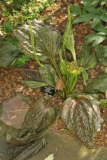Additional notes (click to expand)
Medicinal
The following notes apply to the species of this plant.
Culpeper: ‘Plantago. Plantane... an herb though common, let none despise it, for the decoction of it prevails mightily against tormenting pains and excoriations of the guts, bloody fluxes, it stops the terms and spitting of blood, Phtisicks or consumption of the lungs, the running of the reins and the whites in women, pains in the head and frenzies: outwardly it clears the sight, takes away inflammations, scabs, itch, the shingles, and all spreading sores, and is as wholesome a herb as can grow about a house.
Culpeper, Nicholas. (1650). A Physical Directory . London, Peter Cole.
The following notes apply to the species of this plant.
Medicinal uses
Uses supported by clinical data
No information was found.
Uses described in pharmacopoeias and well established documents
Plantago major is used internally for catarrh of the respiratory tract,
cough, bronchitis, infl ammatory alterations of the oral mucosa, phlegm
congestion, nephritis, cystitis, urinary retention, dysentery, epistaxis
(nosebleed) and excessive diaphoresis (49, 50). It is also used for the treatment
of diarrhoea and constipation (22).
Uses described in traditional medicine
Fresh leaves of Plantago major have been used externally for centuries in
many parts of the world as an antiseptic for treatment of skin irritations,
erysipelas, abscesses, burns, scrofula and infl ammatory reactions of the skin; for repair of damaged tissue; and to treat fi stulae and ulcers (5, 43,
51, 52). It is also used to suppress cough associated with bronchitis, colds
and upper respiratory infl ammation, and as an analgesic and diuretic
agent, in the treatment of kidney stones (53–55). It also has a hepatoprotective
action (4, 56). Plantago major leaves have been used as a weak antibiotic,
astringent (57) and as an immunomodulating (58), antihypertensive
(59), hypoglycaemic (60), haemostatic (61), antiallergic, febrifuge and
antipruritic agent (62). It is used in the treatment of eye infl ammation, and
as a vermifuge (63–65). It is commonly prescribed for treatment of cystitis
with haematuria and haemorrhoids (38).
Contraindications
In case of hypersensitivity to P. major pollen (e.g. contact dermatitis), use
should be stopped.
WHO monographs on medicinal plants commonly used in the Newly Independent States (NIS). 2010. WHO, Geneva
Plantago major 'Rubrifolia'
Family: PLANTAGINACEAEGenus: Plantago
Species: major
Cultivar: 'Rubrifolia'
Distribution summary: Eurasia
Habit: Perennial
Hardiness: H5 - Hardy; cold winter
Garden status: Not currently grown
Reason for growing: Medicinal
